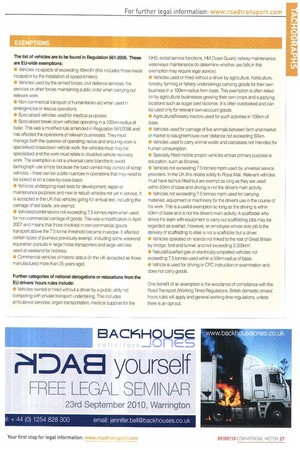The list of vehicles are to be found in Regulation
Page 147

If you've noticed an error in this article please click here to report it so we can fix it.
561-2006. These are EU-wide exemptions: • Vehicles incapable of exceeding 40km/hr (this includes those made incapable by the installation of speed-limiters).
• Vehicles used by the armed forces; civil defence services; fire services or other forces maintaining public order when carrying out relevant work.
• Non-commercial transport of humanitarian aid when used in emergencies or rescue operations.
• Specialised vehicles used for medical purposes.
• Specialised break-down vehicles operating in a 100km-radius of base. This was a modified rule amended in Regulation 561/2006 and has affected the operations of relevant businesses. They must manage both the question of operating radius and ensuring work is specialised breakdown vehicle work: the vehicles must truly be specialised and the work must relate to disabled vehicle recovery work, The exemption is not a universal carte blanche to avoid tachograph use simply because the load carried may consist of scrap vehicles there can be subtle nuances in operations that may need to be looked at on a case-by-case basis.
• Vehicles undergoing road tests for development, repair or maintenance purposes and new or rebuilt vehicles not yet in service. It is accepted in the UK that vehicles going for annual test, including the carriage of test loads, are exempt.
• Vehicles/combinations not exceeding 7.5 tonnes mom when used for non-commercial carriage of goods. This was a modification in April 2007 and means that those involved in non-commercial goods transport above the 7.5-tonne threshold became in-scope. It affected certain types of journeys previously exempt, including some weekend equestrian pursuits in large horse transporters and large vehicles used at weekend for hobbies.
• Commercial vehicles of historic status (in the UK accepted as those manufactured more than 25 years ago).
Further categories of national derogations or relaxations from the EU drivers' hours rules include:
* Vehicles owned or hired without a driver by a public utility not competing with private transport undertaking. This includes ambulance services, organ transportation, medical supplies for the
NHS; social service functions, HM Coast Guard; railway maintenance; waterways maintenance (to determine whether use falls in this exemption may require legal advice).
• Vehicles used or hired without a driver by agriculture, horticulture, forestry, farming or fishery undertakings carrying goods for their own business in a 100km-radius from base. This exemption is often relied on by agricultural businesses growing their own crops and supplying locations such as sugar beet factories. It is often overlooked and can be used only for relevant own-account goods.
• Agricultural/forestry tractors used for such activities in 100km of base.
• Vehicles used for carriage of live animals between farm and market or market to slaughterhouse over distance not exceeding 50km.
• Vehicles used to carry animal waste and carcasses not intended for human consumption.
* Specially fitted mobile project vehicles whose primary purpose is education, such as libraries.
Vehicles not exceeding 7.5 tonnes mpm used by universal service providers. In the UK this relates solely to Royal Mail. Relevant vehicles must have tachos fitted but are exempt as long as they are used within 50km of base and driving is not the driver's main activity.
Vehicles not exceeding 7.5 tonnes mpm used for carrying materials, equipment or machinery for the driver's use in the course of his work. This is a useful exemption so long as the driving is within 50km of base and is not the driver's main activity. A scaffolder who drives his team with equipment to carry out scaffolding jobs may be regarded as exempt. However, an employee whose sole job is the delivery of scaffolding to sites is not a scaffolder but a driver.
• Vehicles operated on islands not linked to the rest of Great Britain by bridge, ford and tunnel, and not exceeding 2,300km2.
• Natural/liquefied gas or electrically-propelled vehicles not exceeding 7.5 tonnes used within a 50km-radius of base.
• Vehicle is used for driving or CPC instruction or examination and does not carry goods.
One benefit of an exemption is the avoidance of compliance with the Road Transport (Working Time) Regulations. British domestic drivers' hours rules will apply and general working time regulations, unless there is an opt-out.
























































































































































































































































